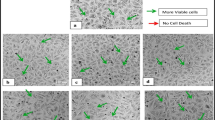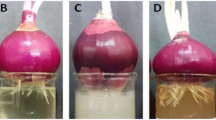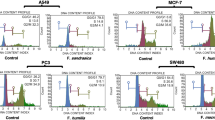Abstract
Cancer is a disorder that results in abnormal and irregular proliferation of cells in the organ or tissue of the body. In Turkey flora, there are many medicinal plants that have great therapeutic importance. Rhaponticoides iconiensis is endemic to Turkey. In the present study, the methanol extracts and sub-extracts of leafy stem and flowers of R. iconiensis were evaluated for cytotoxic activity against Colo 205, A549, HepG2, MCF7 and Beas-2b cell lines by MTT method. The compounds of R. iconiensis extracts were characterized and quantitated by LC–MS/MS. As a result, methanol extracts were not cytotoxic against A549, but were cytotoxic to the Colo 205, HepG2, MCF-7 and Beas-2b cell lines. Among the sub-extracts, dichloromethane, ethyl acetate and n-hexane sub-extracts of flowers and dichloromethane sub-extract of the stem were most cytotoxic against A549, HepG2, MCF-7 and Colo 205 cell lines, respectively. As sub-extracts were most effective against MCF-7 cancer cell line, it can be said that extracts might be effective in estrogen-sensitive cancer cells such as breast and cervix. The cytotoxic effects of sub-extracts can be explained by the variances of compounds and synergistic effects of different secondary metabolites.





Similar content being viewed by others
References
Al ES, Martiskainen O, Sinkkonen J, Pihiaja K, Ayoub N, Singab A, El-Azizi M (2010) Chemical composition and bioactivity of Pleiogynium timorense (Anacardiaceae). Nat Prod Commun 5(4):545–550
Alvarado-Sansininea JJ, Sanchez-Sanchez L, Lopez-Munoz H, Escobar ML, Flores-Guzman F, Tavera-Hernandez R, Jimenez-Estrada M (2018) Quercetagetin and patuletin: antiproliferative, necrotic and apoptotic activity in tumor cell lines. Mol 23:2579. https://doi.org/10.3390/molecules23102579
Astari KA, Erel SB, Bedir E, Karaalp C (2013) Secondary metabolites of Centaurea cadmea boiss. Rec Nat Prod 7(242):244
Bakr RO, Mohamed S, Ayoub N (2016) Phenolic profile of Centaurea aegyptiaca L. growing in Egypt and its cytotoxic and antiviral activities. Afr J Tradit Complement Altern Med 13:135–143
Barros L, Duenas M, Carvalho AM, Ferreira IC, Santos-Buelga C (2012) Characterization of phenolic compounds in flowers of wild medicinal plants from Northeastern Portugal. Food Chem Toxicol 50:1576–1582. https://doi.org/10.1016/j.fct.2012.02.004
Bravo L, Goya L, Lecumberri E (2007) LC/MS characterization of phenolic constituents of mate (Ilex paraguariensis, St. Hil.) and its antioxidant activity compared to commonly consumed beverages. Food Res Int 40:393–405
Bray F, Ferlay J, Soerjomataram I, Siegel RL, Torre LA, Jemal A (2018) Global cancer statistics 2018 GLOBOCAN estimates of incidence and mortality worldwide for 36 cancers in 185 countries. CA: A Cancer J Clin 68(6):394–424
Bremer K, Anderberg AA, (1994) Asteraceae: cladistics & classification. (vol Sirsi) i9780881922752
Chen D et al (2008) Tea polyphenols, their biological effects and potential molecular targets. Histol Histopathol 23(4):487
Clifford MN, Johnston KL, Knight S, Kuhnert N (2003) Hierarchical scheme for LC-MS n identification of chlorogenic acids. J Agric Food Chem 51:2900–2911
Cooper G, Laird A, Nahar L, Sarker SD (2002) Lignan glucosides from the seeds of Centaurea americana (Compositae). Biochem Syst Ecol 30(1):65–67
Çinbilgel İ, Eren Ö, Duman H (2014) Rhaponticoides gokceoglui (Asteraceae), a striking new species from Turkey. Phytotaxa 170(2):125–132
Djeddi S, Argyropoulou C, Skaltsa H (2008) Secondary metabolites from Centaurea grisebachii ssp grisebachii. Biochem Syst Ecol 36:336–339
Doğu S, Bağcı Y, Dinç M (2009) Rhaponticoidesaytachii sp. nov. (Asteraceae) from south Anatolia. Turkey Nord J Bot 27:479–482
Duthie GG, Duthie SJ, Kyle JA (2000) Plant polyphenols in cancer and heart disease: implications as nutritional antioxidants. Nutr Res Rev 13:79–106
Erel SB, Karaalp C, Bedir E, Kaehlig H, Glasl S, Khan S, Krenn L (2011) Secondary metabolites of Centaurea calolepis and evaluation of cnicin for anti-inflammatory antioxidant and cytotoxic activities. Pharm Biol 49(8):840–849
Erel ŞB, Demir S, Kose FA, Ballar P, Karaalp C (2011) Cytotoxic properties of five Centaurea L. species from Anatolia. Planta Med 77(12):149
Eren Ö (2007) The genus Rhaponticoides Vaill (Asteraceae) in Turkey: a new species and first key. Plant Syst Evol 267:13–23
Erol-Dayi Ö, Pekmez M, Bona M, Aras-Perk A, Arda N (2011) Total Phenolic Contents Antioxidant Activities Cytotoxicity of Three CentaureaSpecies: C. calcitrapa subsp calcitrapa C. ptosimopappa C Spicata. Free Radic Antioxid 1:31–36
Fernández-Fernández R, López-Martínez JC, Romero-González R, Martínez-Vidal JL, Flores MIA, Frenich AG (2010) Simple LC–MS determination of citric and malic acids in fruits and vegetables. Chromatogr 72:55–62
Fernandez I, Garcia B, Grancha FJ, Pedro JR (1989) Sesquiterpene lactones, flavonoids and coumarins from Centaurea collina. Phytochem 28:2405–2407
Fischer UA, Carle R, Kammerer DR (2011) Identification and quantification of phenolic compounds from pomegranate (Punica granatum L.) peel, mesocarp, aril and differently produced juices by HPLC-DAD–ESI/MSn. Food Chem 127:807–821
Flamini G, Pardini M, Morelli I, Ertugrul K, Dural H, Bagci Y, Kargioglu M (2002) Flavonoid glycosides fromCentaurea pseudoscabiosasubsp.pseudoscabiosa from Turkey. Phytochem 61:433–437
González RR, Fernández RF, Vidal JLM, Frenich AG, Pérez MLG (2011) Development and validation of an ultra high performance liquid chromatography–tandem mass-spectrometry (UHPLC–MS/MS) method for the simultaneous determination of neurotransmitters in rat brain samples. J Neurosci Methods 198:187–194
Greuter W, Raus T (2010) Med Checklist Notulae, 28. Willdenowia 39:335–345
Grieman M, Greaves J, Saltzman E (2015) A method for analysis of vanillic acid in polar ice cores. Clim of the past 11(2):227–232
Gülcemal D, Alankuş-Çalışkan Ö, Karaalp C, Örs AU, Ballar P, Bedir E (2010) Phenolic glycosides with antiproteasomal activity from Centaurea urvilleiDC Subsp urvillei. Carbohydr Res 345:2529–2533
Güner A, Aslan S, (2012) Türkiye bitkileri listesi:(damarlı bitkiler). Nezahat Gökyiǧit Botanik Bahçesi Yayınları
Hellwig F (2004) Centaureinae (Asteraceae) in the Mediterranean–history of ecogeographical radiation. Plant Syst Evol 246:137–162
Horai H et al (2010) MassBank: a public repository for sharing mass spectral data for life sciences. J Mass Spectrom 45:703–714
Janackovic P, Tesevic V, Milosavljevic S, Vajs V, Marin PD (2004) Sesquiterpene lactones lignans and flavones of Centaurea affinis. Biochem Syst Ecol 32:355–357
Kaija-a-Kamb M, Amoros M, Girre L (1992) The chemistry and biological activity the the genus Centaurea. Pharm Acta Helv 67:178–188
Karaçelik AA, Küçük M, İskefiyeli Z, Aydemir S, De Smet S, Miserez B, Sandra P (2015) Antioxidant components of Viburnum opulus L. determined by on-line HPLC–UV–ABTS radical scavenging and LC–UV–ESI-MS methods. Food Chem 175:106–114
Karamenderes C, Konyalioglu S, Khan S, Khan IA (2007) Total phenolic contents, free radical scavenging activities and inhibitory effects on the activation of NF-kappa B of eight Centaurea L Species. Phytother Res 21:488–491. https://doi.org/10.1002/ptr.2097
Kelebek H, Selli S, Canbas A, Cabaroglu T (2009) HPLC determination of organic acids, sugars, phenolic compositions and antioxidant capacity of orange juice and orange wine made from a Turkish cv. Kozan Microchem J 91:187–192
Köse YB, İşcan G, Göger F, Akalın G, Demirci B, Başer KHC (2016) Chemical composition and biological activity of Centaurea baseri: new species from Turkey. Chem Biodivers 13:1369–1379
Lefort EC, Blay J (2013) Apigenin and its impact on gastrointestinal cancers. Mol Nutr Food Res 57:126–144. https://doi.org/10.1002/mnfr.201200424
Lin L-Z, Harnly JM (2010) Identification of the phenolic components of chrysanthemum flower (Chrysanthemum morifolium Ramat). Food Chem 120:319–326
Lin L-Z et al (2000) Liquid chromatography–electrospray ionization mass spectrometry study of the flavonoids of the roots of Astragalus mongholicus andA Membranaceus. J Chromatogr 876:87–95
Martins L (2007) Identity of Serratula bachtiarica Boiss & Hausskn. and Centaurea bachtiarica Hayek & Bornm. from Iran. Candollea 62:41–43
Martucci MEP, De Vos RC, Carollo CA, Gobbo-Neto L (2014) Metabolomics as a potential chemotaxonomical tool: application in the genus Vernonia Schreb. PLoS ONE 9:e93149
Nature IUfCo (2016) Guidelines for using the IUCN Red List categories and criteria. Standards and Petitions Subcommittee
Nature IUfCo, Commission ISS, Nature IUfCo, Commission NRSS (2001) IUCN Red List categories and criteria. IUCN
Negaresh K, Khoshroo SMR, Karamian R, Joharchi MR (2015) A revision of Rhaponticoides (Asteraceae, Cardueae–Centaureinae) from Iran. Phytotaxa 213(2):87
Prasain JK, Wang CC, Barnes S (2004) Mass spectrometric methods for the determination of flavonoids in biological samples. Free Radic Biol Med 37:1324–1350. https://doi.org/10.1016/j.freeradbiomed.2004.07.026
Puntillo D, Peruzzi L (2009) A new species of Rhaponticoides(Asteraceae) from southern Italy. Folia Geobot 44(2):191–197
Radan M, Carev I, Tesevic V, Politeo O, Culic VC (2017) Qualitative HPLC-DAD/ESI-TOF-MS Analysis, cytotoxic, and apoptotic effects of croatian endemic Centaurea ragusina L. Aqueous Extracts Chem Biodivers 14:e1700099. https://doi.org/10.1002/cbdv.201700099
Rocha LD, Monteiro MC, Teodoro AJ (2012) Anticancer properties of hydroxycinnamic acids-A Review. Cancer and clin oncol 1:109
Rufatto LC, Finimundy TC, Roesch-Ely M, Moura S (2013) Mikania laevigata: chemical characterization and selective cytotoxic activity of extracts on tumor cell lines. Phytomed 20:883–889. https://doi.org/10.1016/j.phymed.2013.03.016
Sarker SD, Laird A, Nahar L, Kumarasamy Y, Jaspars M (2001) Indole alkaloids from the seeds of Centaurea cyanus(Asteraceae). Phytochem 57:1273–1276
Shoeb M, Jaspars M, MacManus SM, Celik S, Nahar L, Kong-Thoo-Lin P, Sarker SD (2007) Anti-colon cancer potential of phenolic compounds from the aerial parts ofCentaurea gigantea (Asteraceae). J Nat Med 61:164
Soliman FM, Moussa MY, Abdallah HM, Othman SM (2009) Cytotoxic activity of flavonoids of Jasonia montana Vahl. (Botsch)(Astraceae) growing in Egypt. Aust J Basic Appl Sci 3:148–152
Tan K, Bancheva S, Vural M, Strid A (2009) Centaurea wagenitziana(Asteraceae: Centaureinae), a new species from the Eastern Balkans. Phytol Balc 15:51–58
Ulubelen A, Öksüz S (1982) Cytotoxic flavones from Centaurea urvillei. J Nat Prod 45:373–373
Wagenitz G, Hellwig FH, (1994) Evolution of characters and phylogeny of the Centaureinae. In: Compositae: Systematics. Proceedings of the International Compositae Conference, Kew. pp 491–510
Wagenitz G, Hellwig FH (2000) The genus Psephellus Cass. (Compositae, Cardueae) revisited with a broadened concept. Willdenowia 30:29–44
Zhu X et al (2004) Simultaneous analysis of theanine, chlorogenic acid, purine alkaloids and catechins in tea samples with the help of multi-dimension information of on-line high performance liquid chromatography/electrospray–mass spectrometry. J Pharm Biomed Anal 34:695–704
Acknowledgements
We are thankful to the Erciyes University Scientific Research Projects Coordinating Unit (project number THD-2019-8713) for financial support. The authors would like to thank Erciyes University Drug Application and Research Center (ERFARMA) for their support in the use of LC–MS/MS in this study.
Author information
Authors and Affiliations
Contributions
We declare that this work was done by the authors named in this article and all liabilities pertaining to claims relating to the content of this article will be borne by the authors. OT and LP contributed to collecting plant samples and extract preparation. LP performed qualitative chemical profiling of the phytoconstituents. ED and MŞ carried out cytotoxic activity tests and data analysis. LP, ED, OT and MŞ were designed the study and contributed to the critical reading of the manuscript. All authors read and approved the final manuscript.
Corresponding author
Rights and permissions
About this article
Cite this article
Tugay, O., Paşayeva, L., Demirpolat, E. et al. Comparative Evaluation of Cytotoxicity and Phytochemical Composition of Centaurea iconiensis (Rhaponticoides iconiensis). Iran J Sci Technol Trans Sci 45, 65–75 (2021). https://doi.org/10.1007/s40995-020-01030-y
Received:
Accepted:
Published:
Issue Date:
DOI: https://doi.org/10.1007/s40995-020-01030-y




